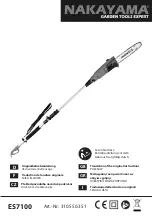
Damaged electrical connection cable
The insulation on electrical connection cables is often dam- aged.
This may have the following causes:
Passage points, where connection cables are passed through windows or doors.
Kinks where the connection cable has been improperly fas- tened or routed.
Places where the connection cables have been cut due to being driven over.
Insulation damage due to being ripped out of the wall outlet.
Cracks due to the insulation ageing.
Such damaged electrical connection cables must not be used and are life-threatening due to the
insulation damage.
Check the electrical connection cables for damage regularly. Make sure that the connection cable
does not hang on the power network during the inspection.
Electrical connection cables must comply with the applicable VDE and DIN provisions. Only use
connection cables with the marking H 05 VV-F, 3x1.5 mm2.
The printing of the type designation on the connection cable is mandatory.
AC motor
The mains voltage must be 220-240 V~
Extension cables up to 25 m long must have a cross-section of
1.5 mm2.
Connections and repairs of electrical equipment may only be carried out by an electrician.
Please provide the following information in the event of any enquiries:
Type of current for the motor
Machine data - type plate
11. Transport
Transport the electric tool by lifting it on the recesses pro- vided for this on the frame and the engine cover.
Never use the protective devices for handling or transport.
Make sure that the exposed part of the saw blade is covered during transport, e. g. by the protective device
12. Cleaning, maintenance, storage and ordering of spare parts
WARNING
Always switch the machine off and remove the mains plug prior to all maintenance and cleaning
work.
12.1
Cleaning
Keep all safety devices, air vents and the motor housing free of dirt and dust as far as possible. We
recommend that you clean the equipment immediately after you use it.
12.1.1 Exterior cleaning
Clean the equipment regularly with a damp cloth and some soft soap.
Do not use cleaning agents or solvents; these may be aggressive to the plastic parts in the equipment.
Ensure that no water can get into the interior of the equipment.
12.1.2 Interior cleaning (fig. 15)
1.
Open the storage box (8).
2.
Remove the screw (36).
3.
Loosen the screw (35).
















































